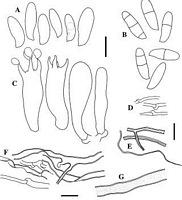|
 Polyporus septosporus Polyporus septosporus
SynonymsPolyporus squamosus
Polyporus udus
Tyromyces udus
BiostatusPresent in region - Indigenous. Endemic
Images (click to enlarge)
Caption: Fig. 5 Polyporus septosporus: A, basidiospores from tubes; B, septate basidiospores from
pileus surface; C, basidia; D, generative hyphae from dissepiments; E, binding hyphae from
dissepiments; F, generative hyphae from context; G, conducting h | 
Caption: Fig. 6 Polyporus septosporus habit; B, C, septate basidiospores from pileus surface (PDD 66261 -
holotype). B,C, bars = 20 µm. |
Article: Buchanan, P.K.; Ryvarden, L. (1998). New Zealand polypore fungi (Aphyllophorales): three new species and a new record. New Zealand Journal of Botany 36(2): 219-231 (http://www.rsnz.org/publish/abstracts.php).
Description: BASIDIOCARPS annual, infundibuliform to convex arising from a contracted base or
more broadly attached, margin down-curved, up to 5.5 cm across, 5 cm from base to
margin, 8 mm thick; pileus surface wrinkled, light brown (57.1 Br) to brown (58.m.Br),
glabrous except for numerous scattered agglutinated bundles of hyphae (appearing
macroscopically as tiny spots) appressed or erect, to almost 1 mm long; pore surface
yellowish brown (76.1y Br- 72.d.OY) except at margin where pores are more reddish
(46.gy.r Br), or pores appearing resinous throughout and then darker reddish brown
(20.d.gy.Red) contrasting with the pale context; pores angular to convoluted, tending to be
radially arranged especially on ascending parts of contracted base, 1-2 per mm, with
dissepiments sometimes fimbriate at edge, extending over whole surface of contracted
base; tubes concolorous, rather brittle, especially when appearing resinous, to 3.5 mm
long; context cream, homogeneous, to 5 mm thick, of loose texture; cortex of dense
texture, brown, 100-200 µm thick. Pileus and pore surfaces stain cherry red on
application of 3% KOH, and colour is persistent; context tissue stains less intensely or
not at all with KOH. HYPHAL SYSTEM dimitic in trama; tramal generative hyphae with
clamps, hyaline, thin-walled, 2-3 µm diam.; tramal binding hyphae hyaline, at widest 4.5
µm diam., with wall thickened to 1.2 µm, branches tapering gradually; appearing
monomitic in context, with hyphae ribbon-like, sparsely clamped, up to 12 µm diam. with
wall to 1 µm thick; conducting hyphae as wide unbranched lengths of generative hyphae
staining strongly in phloxine mountant; cortex formed from a compressed layer of hyphae
oriented parallel to pileus surface, comprising flattened, ribbon-like generative hyphae to
10 µm diam. (though mostly 3.5-4.5 µm diam.) and thick-walled (to 2 µm) hyphae, 3-7
µm diam. which are sparingly branched and appear to lack clamps. CYSTIDIA absent.
BASIDIA clavate, clamped at base, 30-39 x 7-11 µm, 4-sterigmate, with sterigmata
approx. 6 µm long. BASIDIOSPORES elongate-ellipsoid, often with a slight depression
near apiculus on adaxial surface, hyaline, smooth-walled, IKI-, abundant, in tubes
typically nonseptate but rarely to occasionally 1- or 2-septate, on pileus surface at least
some are 1-3-septate, rarely tending to disarticulate at septa, 11-18.5 x 4.3-6.2 µm.
WOOD ROT white.
Habitat: SUBSTRATA: Known from dead wood of ?Dacrycarpus daerydioides, Dacrydium
cupressinum, and Nothofagus truncata.
Distribution: New Zealand: Auckland, Bay of Plenty. Australia: Victoria, Tasmania.
Notes: ETYMOLOGY: septosporus, referring to septation evident in a minority of
basidiospores.
NOTES: This species is separated from all other members of Polyporus by the red
reaction of tissue at the pileus and pore surfaces to KOH, and by the septate
basidiospores. The red reaction was conspicuous in both fresh and dried material of the
holotype, and was less clear though still evident in the darker-coloured dried specimens
in PDD 5391. In NZFRI 1759 the coloration with KOH was reddish brown and less
distinct than in the holotype.
To our knowledge this species is the first member of the Aphyllophorales to be described
with septate basidiospores. Septate spores were readily observed on the pileus surface of
the holotype (Fig. 6B,C), where they outnumber nonseptate spores, but they are rare in
tubes of that specimen. Septate spores are rare on the pileus surface of PDD 5391 and
NZFRI 1759, and were not seen in tubes.
Cunningham (1965) identified PDD 5391 as Tyromyces udus (Jungh.) G.Cunn. (bas.
Polyporus udus Jungh.), and mistakenly described hyphae with simple septa; he did not
report septate basidiospores. P. udus resembles P. septosporus in pore, basidium, and
spore dimensions but, in addition to distinguishing features mentioned above, differs in
being distinctly stipitate and having a different hyphal composition (e.g., dimitic context)
(Nunez & Ryvarden 1995). P. udus is tropical in distribution and is not known from New
Zealand. The identity of two other collections cited by Cunningham (1965) as Tyromyces
udus was not determined.
The holotype (K) of Polyporus tasmanicus Massee 1899, non Berk. 1860 is closely
similar to P. septosporus in microscopic features, although septate spores were not seen.
Massee (1899) reported that his species occurred on the ground, whereas P. septosporus
is lignicolous. Cunningham (1950) identified Massee's material as Polyporus pes-caprae
(Pers.) Fr. (= Albatrellus pes-caprae (Pers.: Fr.) Pouzar), but the latter differs in features
such as the fleshy fruit-body, monomitic hyphal system with inflated hyphae, and
mycorrhizal habit.
|